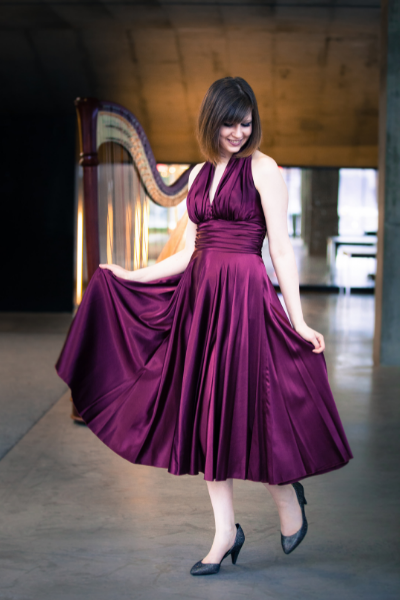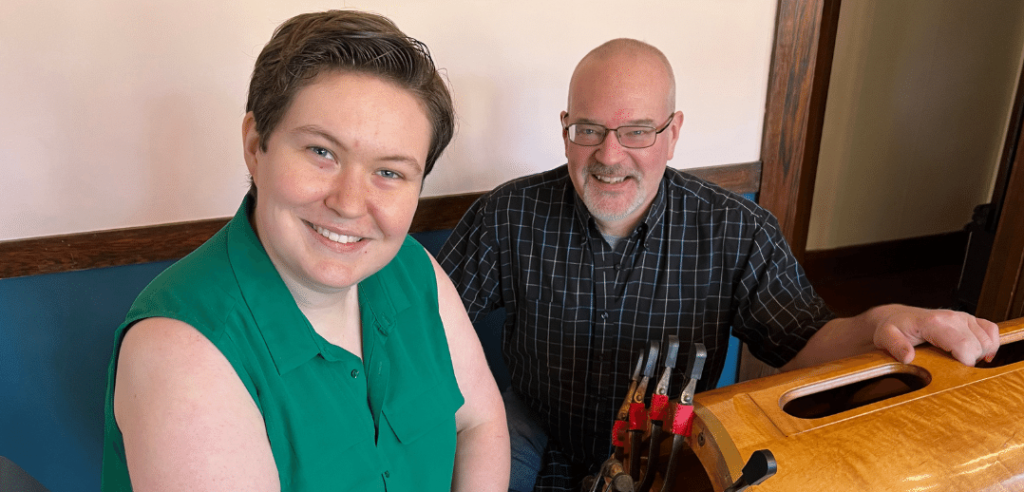This article is the second in a new Harp Column series that gives readers a glimpse into different careers in the harp world. The ways to make a living with the harp are as interesting and diverse as the people carving their own niches. Stay tuned to see who we shadow next. Is there a harp-related career you’d like to see featured? Let us know! Tag us on social media @harpcolumn or email us at info@harpcolumn.com.
Social media content creators are at the cutting edge of today’s technology and cultural trends. In this issue, we’re asking Kristan Toczko to show us what the world of social media looks like, especially for harpists. Toczko is an accomplished classically-trained Canadian harpist who’s won international competitions, but she’s perhaps best known for her TikTok videos. She joined the social media platform in 2020. Within less than a year, she grew her channel to over 800,000 followers. Now with two million followers, she arranges and shares all kinds of music in her videos, from classical to pop to video game music. She also creates educational videos about the harp, and makes her arrangements available to the public. Toczko also loves teaching harp and piano lessons through her online studio.
How did you get started as a social media content creator?
Brush up on social media slanguage.
I was bored when the pandemic hit. I was scrolling through my cell phone trying to find new games to download, and I found TikTok (a short-form video sharing app). It was super fun and addicting! I noticed there were also some professional musicians on the app. I thought, “Maybe I’ll share a video here, because it sounds like a fun platform.” I really like movie music and film music, so I shared a song cover, just to see how it would do. When I shared it, I got quite a lot of views, likes, and comments. No one was following me on TikTok, but I still got tons of comments, so that piqued my interest.
Later I noticed there was a trending sound on TikTok of a harpist performing. Hannah Stater, who is based in Florida, started this trend. It’s a tune called “A Moment Apart” by Odesza. It’s super simple—just broken arpeggios. I decided to try my own song cover of it, and that was my first viral video.
What are your goals as a social media content creator? What do you want your audience to gain from viewing your content?

My goals have developed over the past couple years of being on TikTok. It started off as a fun place to share my music, especially my love of film music and video game music. And then I started getting messages from people saying, “Oh my goodness, your music is so calming and peaceful. I live with anxiety, and I watch your videos every day.” “I live with anger issues, and your music calms me down.” “I live with depression, and your videos have really uplifted me.” “I love your character, your genuineness on the platform.” So I realized I’m actually bringing joy to people’s lives.
Also, I have a passion for teaching, and it warms my heart hearing comments like, “You inspired me to pick up my trumpet again,” or even, “You inspired me to buy a harp.” That is so cool.
What does a typical work session look like, for your social media channels?
When I have a block of time, I set up my tripod with a ring light and a phone holder on it. I record on my phone, with an external microphone that clips right onto my music stand. What’s great about this is it plugs directly into my cell phone. The sound quality is actually pretty good for talking, and for harp as well.
When I sit down and record, I have a few lists I go through. You can favorite comments on TikTok, so I have 300-plus comments with song requests. So I scroll through and decide what I’m in the mood for learning. Sometimes I do classical pieces like symphony arrangements for solo harp. Sometimes I do video game music or popular songs. I do try to pace it out, because I know some of them are really hard. I sometimes do a few super easy covers plus one or two hard ones.
When I do song covers, I just go on Google to find piano music, and I use that as my skeleton for my own arrangement of 15 or 30 seconds of music.
What types of content do you share?
I started with just song covers and video game covers, because I was a little bit shy to talk in my videos and share that publicly. Now I do more talking to showcase more of what the harp can do, because not many people see the classical harp every day. I like to do music that will make people listening to it think, “Whoa, that’s a harp? I didn’t know you can do that on a harp.” So I share extended techniques on TikTok. I share teaching videos about the harp. I get so many questions, like “What do the different colored strings mean? What do the pedals do?” I also share practicing tips and freelance tips.
How do you come up with ideas for new content?
I see what is trending in culture. For example, there was a new Xbox game that came out called Halo. Everyone was asking for it, so I shared a cover on the video game’s release date and it went viral, because it was culturally relevant. I also choose content from my comments sections, because people are asking me to do popular songs.
How frequently do you share new content?
I share one to five videos every day. I batch-record—I don’t get all dressed up and sit down at my harp every day. I usually have about 20 to 30 videos in the bank, ready to share.
How long are your videos?
Videos are under 59 seconds for TikTok, which is my main platform. Right now, videos that are between 15 and 20 seconds are doing very well.
How did you get comfortable talking into a camera?
I used to be an incredibly shy person. I’d get freaked out if I had to talk in a classroom or in social settings. Teaching, especially over Zoom, has helped how I speak.
I started with trends, which are audios that someone else has created. You can lip-sync to it and you make a joke about it or apply it to your niche. I started with that, to ease into showing my face and talking, but no one could hear my voice.
And then I learned about editing in the app, which was fantastic because I didn’t have to be afraid of pauses or stumbling over words. I write out my scripts. I memorize one sentence at a time, look at the camera, and say it. I try to remember my inflection of what I just ended, to make it seem like it’s natural when I edit it and put the clips together.
How do you get paid for creating social media content?
There are several streams for monetization. I was approached by a sheet music website to start selling my arrangements on their website. I’ve gotten requests for custom recordings of songs, especially for weddings. Some people have requested a backtrack for an album they’ve created. I also have a couple of recordings available for purchase. I’ve gotten a lot of students through TikTok, just by sharing my educational videos and making the harp accessible to people.
And then brand deals are super fun. Brands have been asking me to partner with them. They’ll either pay me or send me a free product, and ask if I can showcase their product in my videos. There are a couple brands I’m now partnered with long-term. One of them is a microphone company. They send me their gear, whenever they have new stuff out, or anytime I need something. I also partner with a tuner company. I’ve used their tuner app for years, because it’s so accurate. I actually reached out to them to see if they wanted to collaborate. It’s super fun to help out these brands. I truly believe in their products and want to promote them, so it’s a win-win for everyone.
Is it a full-time job creating social media content, or do you have other work?
In terms of the hours I put in, yes. I spend a certain amount of time to keep the standard I’ve set for myself. In terms of the income, right now it’s not a full-time gig. I’ve discovered, though, that I make more money now than I was when I was freelancing full-time before the pandemic, because I’ve been funneling my followers into other streams of income. I still love doing orchestra work and freelancing, but it’s nice to just stay at home and earn money in other ways.
If I didn’t have social media, I feel like I wouldn’t have built my profile as much. I wouldn’t be getting as many students and recording projects. People are seeing daily videos of me performing, so they know my fingers are in good shape, and they’re more likely to hire me for gigs. I think it’s helped to get my name out there.
What parts of your educational or musical background prepared you for doing social media?
Definitely being a good, well-rounded musician helps.
I did a lot of observing, and that’s how I developed the skills of how to video something with the best angle, or how to engage with my followers. I watched a lot of movies and TV, and I saw how they filmed things—what makes a good transition, or what is a good amount of time to spend on one camera angle.
I learned about high-quality audio recordings when I was at McGill University. They have a really great sound engineer program, and I had a lot of friends in the program who often needed someone to record.
I also observed other successful social media content creators. I thought about why their video performed well. What did I like and not like about this video? What kept my interest? I also follow TikTok coaches who share tips on how to shoot videos.
What do you love most about creating content?
Videos are another creative outlet for me. I love creating things—creating music on my harp, creating drawings and paintings, and now creating videos for social media.
Are there any struggles you have with social media?
If you do go viral on social media, there’s quite a negative side to the internet, in terms of hate comments. I have to set boundaries. It’s not possible to censor hate comments when reading them, so once I read something, it’s there in my head. So then I have to choose what to do with that comment afterwards. I try to give one second of my time to those comments, and then I need to move on. Delete, block, move on in my life.
But the positives of social media definitely outweigh the negatives. Sometimes I share a video and it doesn’t go viral, but that’s okay. Even if there is one person that found my video helpful, it’s for that one person that I do these videos.
What opportunities does social media offer for today’s musicians?
Having a presence on social media has helped me get gigs. I’ve gotten asked to play concerts after posting on social media about competitions I’ve won.
I’ve noticed since I’ve built my profile up, people are looking to hire Kristan Toczko, not just “a harpist.” After watching my videos on TikTok, people say, “I’d love to study with you, because I noticed your hands are really relaxed. I love your personality and how bubbly and smiley you are.”
And it’s not just building my profile in my local city. I’ve had people reach out from as far as Europe and Australia for recording requests and wanting harp lessons.
What do you imagine the future of social media will look like?
With social media, things are changing so quickly, I never know where they’re going next. I think it’s really important to observe what’s hot right now, and jump on that trend. I see videos are hot right now, so that’s what I’m sharing. That’s why I think I was successful. When TikTok got started, I jumped on early, and it was easy to grow a large following.
What is your advice for readers who want to build their own social media following?
Just post. Get your content out there. Record everything and anything. It could be how you tune, how you change a string, how you move your harp. If you’re doing a recording somewhere, you can just do a panorama of the concert hall and put text on the screen, “Looking forward to recording here later this afternoon,” and just keep it simple. You can also follow people who are in your niche to get ideas.
Don’t be afraid to post and be judged. Treat it like a recital. You play and it’s done. It’s hard because the videos are there forever, but it’s okay that your content shows growth over time. I can go back to my old videos and see how I played, the mistakes that I made, my poor video and audio quality, and how unenthusiastic I was with the camera. But I’ve grown and that’s not who I am now, so I have to let go of judging myself.
A lot of times, people are too scared to talk on social media. It doesn’t have to be perfect. You can say “um.” You’re allowed to have mistakes. Just get out on social media and show the fun and genuine side of yourself. We don’t want to see perfect material; we want to see the true you. I even did a bloopers outtake of me trying to record a song cover, and showing all the mistakes I made. Especially in classical music, there’s a feeling that if it’s not perfect, it’s not good. And we need to break that perfectionism. •
Social media slanguage
TikTok: a social media app where users share videos of up to three minutes in length, although many videos are as short as 15 seconds. As of March 2022, Toczko has shared almost a thousand videos on TikTok. Some of her favorite videos involved experimenting with new sounds on the harp. “I have a lot of fun trying new things and creating new sounds,” she says. “For example, I tried paperclips—using them to pluck, hanging them around the strings, and also threading them through the strings and watching them pop off as I played.”
Handle: a content creator’s username, which often follows an @ symbol. Toczko’s social media handle is @harpistkt.
Followers: people who sign up to be notified when the content creator they are following shares new content. Each social media content creator’s account shows the number of followers they currently have. Tozcko started her TikTok account in 2020; within less than a year, she gained over 800,000 followers. As of March 2022, she has two million followers.
Views: different social media platforms count views differently, but on TikTok, as soon as a user begins watching a video, it counts as one view. The most views Tozcko ever received was 22.6 million views, on her song cover of “SugarCrash!” by Canadian musician ElyOtto.
Likes: some social media platforms have a “like” button that viewers can click to show that they enjoyed a post. Tozcko’s cover of “SugarCrash!” received 4.2 million likes.
Comments: a social media user’s response to a post, which can be viewed by the content creator and by anyone else viewing the post. Toczko’s cover of “SugarCrash!” received 59,000 comments.
Trending sound: when many people start making videos using a specific audio, either from TikTok’s audio library or from a video someone created.
Going viral: when a video picks up a lot of traction quickly. For smaller accounts, viral could mean more than 20,000 views. Toczko defines a viral video as one that gets more than 500,000 views overnight.
Brand deals: when a content creator agrees to make one or more videos featuring a brand, in exchange for a free product and/or money. Some brand deals are long-term partnerships; others are just one video.













